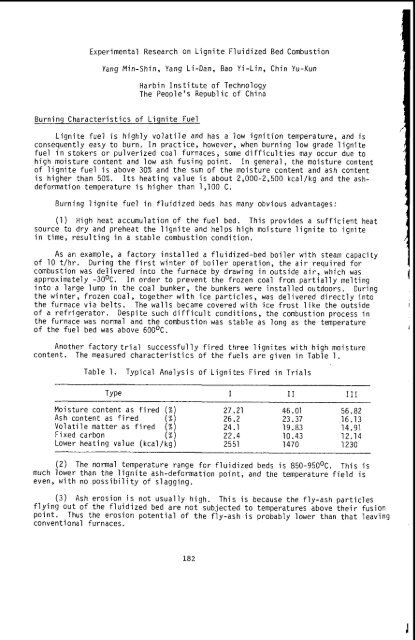the coking properties of coal at elevated pressures. - Argonne ...
the coking properties of coal at elevated pressures. - Argonne ...
the coking properties of coal at elevated pressures. - Argonne ...
You also want an ePaper? Increase the reach of your titles
YUMPU automatically turns print PDFs into web optimized ePapers that Google loves.
Experimental Research on Lignite Fluidized Bed Combustion<br />
Yang Min-Shin, Yang Li-Dan, Bao Yi-Lin, Chin Yu-Kun<br />
Burning Characteristics <strong>of</strong> Liqnite Fuel<br />
Harbin Institute <strong>of</strong> Technology<br />
The People's Republic <strong>of</strong> China<br />
Lignite fuel is highly vol<strong>at</strong>ile and has a low ignition temper<strong>at</strong>ure, and is<br />
consequently easy to burn. In practice, however, when burning low grade lignite<br />
fuel in stokers or pulverized <strong>coal</strong> furnaces, some difficulties may occur due to<br />
high moisture content and low ash fusing point.<br />
In general, <strong>the</strong> moisture content<br />
<strong>of</strong> lignite fuel is above 30% and <strong>the</strong> sum <strong>of</strong> <strong>the</strong> moisture content and ash content<br />
is higher than 50%. Its he<strong>at</strong>ing value is about 2,000-2,500 kcal/kg and <strong>the</strong> ash-<br />
deform<strong>at</strong>ion temper<strong>at</strong>ure is higher than 1,100 C.<br />
Burning lignite fuel in fluidized beds has many obvious advantages:<br />
(1) High he<strong>at</strong> accumul<strong>at</strong>ion <strong>of</strong> <strong>the</strong> fuel bed. This provides a sufficient he<strong>at</strong><br />
source to dry and prehe<strong>at</strong> <strong>the</strong> lignite and helps high moisture lignite to ignite<br />
in time, resulting in a stable combustion condition.<br />
As an example, a factory installed a fluidized-bed boiler with steam capacity<br />
<strong>of</strong> 10 t/hr. During <strong>the</strong> first winter <strong>of</strong> boiler oper<strong>at</strong>ion, <strong>the</strong> air required for<br />
combustion was delivered into <strong>the</strong> furnace by drawing in outside air, which was<br />
approxim<strong>at</strong>ely -3OOC. In order to prevent <strong>the</strong> frozen <strong>coal</strong> from partially melting<br />
into a large lump in <strong>the</strong> <strong>coal</strong> bunker, <strong>the</strong> bunkers were installed outdoors.<br />
<strong>the</strong> winter, frozen <strong>coal</strong>, toge<strong>the</strong>r with ice particles, was delivered directly into<br />
<strong>the</strong> furnace via belts. The walls became covered with ice frost like <strong>the</strong> outside<br />
<strong>of</strong> a refriger<strong>at</strong>or. Despite such difficult conditions, <strong>the</strong> combustion process in<br />
<strong>the</strong> furnace was normal and <strong>the</strong> combustion was stable as long as <strong>the</strong> temper<strong>at</strong>ure<br />
<strong>of</strong> <strong>the</strong> fuel bed was above 60OoC.<br />
Ano<strong>the</strong>r factory trial successfully fired three lignites with high moisture<br />
content. The measured characteristics <strong>of</strong> <strong>the</strong> fuels are given in Table 1.<br />
Table 1. Typical Analysis <strong>of</strong> Lignites Fired in Trials<br />
Type I I1 I11<br />
Moisture content as fired (%) 27.21 46.01 56.82<br />
Ash content as fired (%) 26.2 23.37 16.13<br />
Vol<strong>at</strong>ile m<strong>at</strong>ter as fired (%) 24.1 19.83 14.91<br />
Fixed carbon (%I 22.4 10.43 12.14<br />
Lower he<strong>at</strong>ing value (kcal/kg) 2551 1470 1230<br />
(2) The normal temper<strong>at</strong>ure range for fluidized beds is 850-950°C. This is<br />
much lower than <strong>the</strong> lignite ash-deform<strong>at</strong>ion point, and <strong>the</strong> temper<strong>at</strong>ure field is<br />
even, with no possibility <strong>of</strong> slagging.<br />
Ouring<br />
(3) Ash erosion is not usually high. This is because <strong>the</strong> fly-ash particles<br />
flying out <strong>of</strong> <strong>the</strong> fluidized bed are not subjected to temper<strong>at</strong>ures above <strong>the</strong>ir fusion<br />
point. Thus <strong>the</strong> erosion potential <strong>of</strong> <strong>the</strong> fly-ash is probably lower than th<strong>at</strong> leaving<br />
conventional furnaces.<br />
182

















